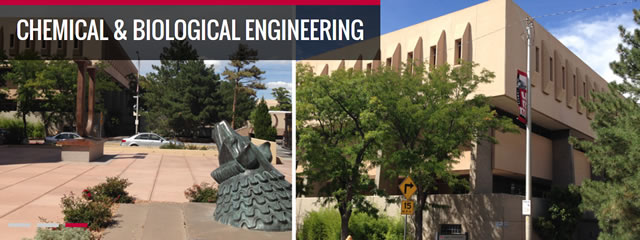
Chemical and Biological Engineering ETDs
Publication Date
2-9-2011
Abstract
Direct ethanol fuel cells are especially important among emerging electrochemical power systems with the potential to offset a great deal of the energy demand currently met through the use of fossil fuels. Ethanol can be refined from petroleum sources or attained from renewable biomass, and is more easily and safely stored and transported than hydrogen, methanol or gasoline. The full energy potential of ethanol in fuel cells can only be realized if the reaction follows a total oxidation pathway to produce CO2. This must be achieved by the development of advanced catalysts that are electrically conductive, stable in corrosive environments, contain a high surface area on which the reaction can occur, and exhibit a bi-functional effect for the ethanol oxidation reaction (EOR). The latter criterion is achievable in mixed-metal systems. Platinum is an effective metal for catalyzing surface reactions of many adsorbates and is usually implemented in the form of Pt nanoparticles supported on inexpensive carbon. This carbon is believed to be neutral in the catalysis of Pt. Instead, carbon can be replaced with carefully designed metals and metal oxides as co-catalysis or support structures that favorably alter the electronic structure of Pt slightly through a strong metal support interaction, while also acting as an oxygen source near adsorbates to facilitate the total oxidation pathway. Niobium mixed-metal-oxides were explored in this study as bi-functional catalyst supports to Pt nanoparticles. We developed a thermal aerosol synthesis process by which mesoporous powders of mixed-metal-oxides decorated with Pt nanoparticles could be obtained from liquid precursors within ~5 seconds or less, followed by carefully refined chemical and thermal post-treatments. Exceptionally high surface areas of 170-180m2/g were achieved via a surfactant-templated 3D wormhole-type porosity, comparable on a per volume basis to commercial carbon blacks and high surface area silica supports. For the first time, in situ FTIR measurements in acid electrolyte showed that highly dispersed Pt nanoparticles (2-5nm) on NbRuyOz (at% 8Nb:1Ru) catalyze the formation of CO2 from ethanol in greater yield, and 0.35-0.4V lower, than Pt(111). Compared to conventional Pt/carbon, this indicates that, (1) Pt supported on NbRuyOz can be more effective at splitting the C—C bond in ethanol and, (2) the scission occurs at potentials more ideal for a higher efficiency fuel cell anode. Ex situ-microscopy revealed the polarization-induced two- and three-dimensional formation of Pt-NbOx interfacial adsorption sites responsible for the facilitation of the total oxidation pathway of ethanol. The results show that synthesis and post-treatment of niobia supports can bias the utility of Pt/niobia systems towards the ethanol oxidation reaction at the anode or the oxygen reduction reaction at the cathode. Experimental and computational-theoretical analyses indicate that the mechanism of interfacial site formation is dependent upon the local oxygen concentration, as well as the availability of multiple, energetically accessible oxidation states like those inherent to niobia. Future directions for the development of highly active, niobium-based materials tailored for efficient catalysis of the total oxidation pathway of ethanol are discussed.
Keywords
Fuel Cell, Electrochemistry, Ethanol Oxidation, Niobium oxide, Niobia
Sponsors
Department of Energy #DE-PS02-08ER08-04
Document Type
Dissertation
Language
English
Degree Name
Chemical Engineering
Level of Degree
Doctoral
Department Name
Chemical and Biological Engineering
First Committee Member (Chair)
Atanassov, Plamen
Second Committee Member
Datye, Abhaya
Third Committee Member
Ward, Timothy
Fourth Committee Member
Luhrs, Claudia
Fifth Committee Member
Kiefer, Boris
Recommended Citation
Konopka, Daniel. "Aerosol Synthesis and Electrochemical Analysis of Niobium Mixed-Metal Oxides for the Ethanol Oxidation Reaction in Acid and Alkaline Electrolyte." (2011). https://digitalrepository.unm.edu/cbe_etds/5


